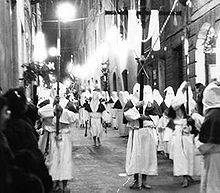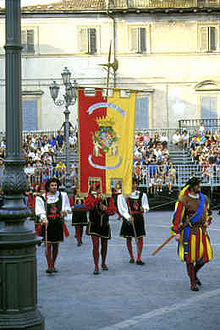Cagli
| Cagli | ||
|---|---|---|

|
|
|
| Country | Italy | |
| region | Brands | |
| province | Pesaro and Urbino (PU) | |
| Coordinates | 43 ° 33 ' N , 12 ° 39' E | |
| height | 276 m slm | |
| surface | 226.3 km² | |
| Residents | 8,366 (Dec 31, 2019) | |
| Population density | 37 inhabitants / km² | |
| Post Code | 61043 | |
| prefix | 0721 | |
| ISTAT number | 041007 | |
| Popular name | Cagliesi | |
| Website | Cagli | |
Cagli is an Italian city with 8,366 inhabitants (as of December 31, 2019) on the Via Flaminia in the province of Pesaro and Urbino in the Marche region .
geography
The city lies on a plateau of Monte Petrano at the confluence of the Burano and Bosso rivers, tributaries of the Metauros . In addition to the main town, the following districts belong to the municipality: Abbadia di Naro, Acquaviva, Ca 'Bargello, Cerreto, Foci, Massa, Moria, Paravento, Pianello, Pieia, Secchiano and Smirra. The municipality belongs to the Comunità Montana del Catria e del Nerone .
The neighboring municipalities are Acqualagna , Apecchio , Cantiano , Fossombrone , Frontone , Gubbio ( PG ), Pergola , Pietralunga (PG), Piobbico and Urbania .
history
The city of Cagli was the capital of the Byzantine Pentapolis in the 6th century and was mentioned several times on Roman routes. In the 4th century, Servio Onorato explained the possible misunderstanding in a commentary on the Aeneid of Virgil : "Cales civitatis (today's city of Cagli), est Campanile, nam in Flamina est, quae Cale (the so-called Cagli) dicitur". In the 12th century, Cagli became a free city and soon conquered 52 fortresses, so that the rural aristocracy and the feudal rule of the abbots was abolished. With the city limits the area of influence of the jurisdiction of the diocese of Cagli , where Greciano became the first bishop in the 4th century, expanded. Partly destroyed by a fire started by the Ghibellines in 1287, the city was moved to the foothills of Mount Petrano and rebuilt in the plateau on top of a previously existing village. The re-establishment took place according to the city map according to orthogonal axes Arnoldo di Cambios in 1289 and thanks to the help of Nicholas IV. Leon Battista Alberti strongly influenced the future urban structure for the development of his “ideal city”. This includes some elements that can be seen in the famous work of Laurana (employee of Alberti), such as the plateau of Mount Petrano. These connections between the “ideal city” and Cagli are not just a coincidence; the latter was very much appreciated by the Montefeltros . On the other hand, Franceschini wrote that the emergence of the rule of the Montefeltro took place in the Papal States , "according to the will of the royal family, the city of Urbino, Cagli and its surrounding region." In addition, “the city of Urbino and Cagli concluded a treaty on an equal footing with the alliance of 1367”.
Cagli soon became a thriving castle, despite a fire in 1278 that slowed development. You can see from a fee that was paid to the church in 1312 that Cagli registered a sharp decrease in population due to a famine and had around 7,200 inhabitants. Later, in 1357, Cagli was listed in the Constitutiones Aegidianae among the nine magnae civitates of the Marca (among these Fano and Fossombrone, which belonged to the province of Pesaro). The development of manufactured goods, especially the processing of wool (later also silk ) and leather , greatly helped the city under the rule of the Dukes of Urbino . The inclusion in the Papal States in 1631 by Pope Urban VIII had a major influence on Cagli's policy: as in all of Marche, grain production became the most important industry. For this reason the Apennine region suffered heavy economic losses. In the course of time the city lost its art-historical importance. The city's art and cultural treasures were destroyed in an earthquake in 1781 and stolen during looting during the Napoleonic era. With the unification of Italy, the first anti-clerical protests began. The construction of the Fano-Fabriano-Rome railway line and the construction of the new municipal theater and public buildings have greatly changed and developed the city. There were also many confiscations in monasteries and brotherhoods. The destruction of the train station in 1944 by the National Socialists and the loss of the Flaminia transport connection also meant a decline in the history of Cagli and its surroundings, which, however, developed positively in the second half of the 20th century.
Attractions
Main tower ( Rocca Torrione )
The construction of the fortification was planned by Francesco di Giorgio Martini for Duke Federico da Montefeltro . The ingenious architect described the Caglis fortress with precise details in his treatise as the first of the six symbolic strongholds. The secret walkway, called “Soccorso Coverto”, which connects the main tower with the imposing ruins of the diamond-shaped fortress, is impressive. This was destroyed in 1502. The fortification was built by Francesco di Giorgio Martini during a fertile period when artists like him introduced innovations and solutions to address problems such as the use of firearms. The rooms accommodate the Center for Contemporary Sculpture ( Centro di Scultura Contemporanea ) with works by artists such as Alamagno, Coletta, Gastini, Icaro, Kounellis , Lorenzetti, Mattiacci, Nagasawa, Nunzio, Paolini , Porcari, Uncini and Zorio .
City Hall and Archaeological Museum
Matteottiplatz, which was the old main square, is overlooked by the 13th century city building that is the seat of the judges' office. The building was merged with the Palazzo del Podestà (with a monumental facade by Alessandri) and was donated by the city to Federico da Montefeltro in 1476. He was also the client of the changes to the Palazzo Ducale that Francesco di Giorgio Martini was supposed to complete. These include lowering the main entrance, erecting a box whose corbels can still be seen, and rooms with vaults. The clock was built by Finale in 1575, while the Virgin and Child statue was ordered in Venice in 1680. On the side of the unadorned entrance there are three units of measurement (foot, arm and pipe), as well as the stump of a Roman column (called cagliese), which stands in the hall on the ground floor. Here in 1536 frescoes of the Virgin and Child, St. Michael the Archangel and St. Geronzio by Giovanni Dionigi were painted in the arched fields. In the hall, which also contains the archaeological museum, finds of the arms of the Feltreschi and Rovereschi, city arms with the Archangel Michael and a pair of dolphins are exhibited. From this room you enter the dungeons of the palace (to the left of the entrance from the piazza), where there are ceramic fragments and pieces of tombstones from the Middle Ages that were found during an excavation. Among these are: the mayor's coat of arms, capitals, rose windows, Roman-style decorations and pipes of the city's water network. At the exit from the council hall there is a passage with a portal from the 15th century and a bas-relief with Frederician symbols below a fresco. From here you step back into a courtyard, where a statue, called Cosmic Order, by Eliseo Mattiacci from 1997 stands in the middle and from which you can get to the Archaeological Museum and the Museum Flaminia (still under construction). These are located in the halls of the 13th century Palais des Podestà. In the middle of Piazza Matteotti there is a fountain by Giovanni Fabbri, which was built in 1736 according to a plan by Anton Francesco Berardi.
cathedral
The Chiesa di Santa Maria Assunta is now the co- cathedral of the diocese of Fano-Fossombrone-Cagli-Pergola . It has been redesigned over the course of a century since 1646. The Gothic portal on the left belongs to the medieval structure, contains a 17th century painting by Ludovico Viviani from Urbino and was built by master Antonio di Mastro Cristoforo from Cagli in 1424. Due to an earthquake in 1781, Pietro Giacomo Patriarca's high dome was replaced by the modern half-dome. The octagonal aedicula of the bell tower was also built from brick according to the plan of 1790 by Giovanni Antinori . The main works are the paintings by Gaetano Lapis from 1758 in the second chapel and the right nave, and those by Sebastiano Conca from 1720 in the third chapel; in the transept are Luigi Garzi's patron saints, dated 1704, the Virgin and Child, Saints Peter and John the Baptist, commissioned by the Medici family in 1695 from the painter Nasini; in the Chapel of the Holy Sacrament there are two paintings by Gaetano Lapis from 1754 and 1756; in the left nave still the announcement of the Barocci workshop, a fragment of the fresco of the Immaculate Virgin from the 16th century attributed to Giuliano Persciutti from Fano, but possibly painted by the painter Dionigi from Cagli, and the tympanum of the altar of the Eternal Father from the 17th century by Giambattista Gambarini. The organ was built by Nicola Morettini in 1889.
Good Friday procession
A particularly poignant celebration takes place here on Good Friday. The procession starts late in the afternoon and after the inspection in the cathedral it leads to the church of St. Joseph and ends in front of it with two groups: the Mater dolorosa and Christ opposite her. In the evening, four hundred barefoot monks, who also wear hoods and belong to five brotherhoods, follow a parade that has preceded the car with the veiled Christ since the 16th century.
Corpus Christi procession
Since the 15th century, the population and the faithful have been celebrating the Corpus Domini procession with flowers that decorate the whole city. He is accompanied by the Brotherhood of the Holy Sacrament and the priest shows the city the monstrance with the holy host during the procession.
Historical parade ( Palio ) Giuoco dell'Oca
The old quarrel between the historical quarters of the city dates back to 1543. On the evening before (2nd Saturday in August), the captains receive the costumes and the patron is given oil; afterwards, the festival is celebrated in each quarter with old customs and typical food. On the day of the parade (2nd Sunday in August), the judge followed by the march shows the goose (Italian: oca) that is to be won. In a game of dice you choose a player who is representative of his quarter and wins on points. These are shown on a display board of 54 boxes by competitors of each team who have to move on it. The latter also carry out fights, the loser of which must be relegated. In the evening you either celebrate or you can comfort yourself in the local inns.
sons and daughters of the town
- Filippo Castracane degli Antelminelli (1851–1899), Archbishop, President of the Pontifical Diplomatic Academy
- Angelo Celli (1857–1914), physician, bacteriologist and hygienist as well as malaria researcher (named after Plasmodium malariae )
Web links
- Entry at Italia in dettaglio (Italian and English)
- Entry at Comuni italiani
- Official site of the city
Individual evidence
- ↑ Statistiche demografiche ISTAT. Monthly population statistics of the Istituto Nazionale di Statistica , as of December 31 of 2019.
- ^ Page of the Palio , accessed March 17, 2019 (Italian)





